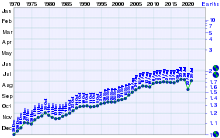地球超载日(英語:Earth Overshoot Day,EOD ),又称作生态负债日(英語:Ecological Debt Day,EDD),是一个计算出的日期,它表示在这一天,人类的资源消耗超过了地球本年度再生这些资源的能力。“超载”表示人类人口的需求超过地球上再生生物资源的可持续水平。从经济角度看,每年的地球超载日表示地球的本年度再生预算在这天耗尽,人类进入环境赤字支出。 地球超载日的计算方法是世界生物承載力(本年度地球产生的自然资源量)除以世界生態足跡(当年人类对地球自然资源的消费),再乘以365(闰年为366),即一年中的天数:

2020年,由于冠状病毒在全球范围内引发大规模封锁,计算出的超载日落在8月22日(比2019年晚了三周多)。[2]全球足跡網絡主席称, COVID-19大流行本身就是“生态失衡”的表现之一。[3]
地球超载日由全球足迹网络计算,是一项得到数十家其他非营利组织支持的活动。[4]有关全球足迹网络的计算[5]和国家生态足迹的信息可在线获取。[6]
背景
编辑| 年 | 地球超载日 | 年 | 地球超载日 | |
|---|---|---|---|---|
| 2017年 | 8月2日 | 2021年 | 7月29日 | |
| 2018年 | 8月1日 | 2022年 | 7月28日 | |
| 2019年 | 7月29日 | 2023年 | 8月2日 | |
| 2020年 | 8月22日 | 2024年 | 8月1日 |
英国智庫新经济基金会的安德鲁·西姆斯最早提出了地球超载日的概念。全球足跡網絡是新经济基金会的合作伙伴组织,每年都会发起地球超载日活动,以提高人们对地球资源限度的认识。全球足迹网络衡量人类对自然资源和生态服务的需求和供应。他们估计,2022年,在不到七个月的时间里,人类对大自然的需求就超过了地球生态系统全年的再生能力。[4]人类需求包括所有竞争地球表面再生能力的需求,例如可再生資源、 CO2封存和城市空间。
根据全球足迹网络的研究,在人类历史的大部分时间里,人类利用自然资源建造城市和道路、提供食物、制造产品、排放二氧化碳的速度完全在地球预算范围内。但到了20世纪70年代初,临界点已经突破:人类的消耗量开始超过地球的再生能力。按照他们的说法,目前人类对资源的需求量相当于1.7个地球以上。[7]数据显示,我们可能在21世纪中叶之前就需要相当于两个地球的资源。他们指出,资源枯竭的代价正变得越来越明显。气候变化(由温室气体排放导致)的后果最为明显,影响最为广泛。其他生物物理影响包括:森林砍伐、物种丧失、水土流失或渔业崩溃。这种资源不安全会导致经济压力(如货币通胀)和冲突(如内乱)。[4]
全球足迹网络认为,生态足迹账户记录了人类需求与再生能力之间的差距。他们说,现在的需求已经超过了地球的再生能力。他们承认核算方法有改进空间,还可增加更多细节,认为目前应用在各国的计算方法通常低估了人类需求,因为并非所有方面都得到了衡量(联合国数据存在差距)。他们还声称高估了生物承载力,因为很难确定当前的再生量中有多少是以未来量的减少为代价的(例如过度使用地下水或水土流失的情况)。[8]全球足迹网络的创始人兼总裁Mathis Wackernagel表示,农田的土壤退化可以包含在计算地球超载日的生态足迹账户中,但这“需要联合国数据集中不存在的数据集”。[9]因此,他们称,生态足迹账户是仅定义可持续性最低条件的指标,并且人类对地球的影响可能高于他们的账户所揭示的结果。
参考文献
编辑- ^ Past Earth Overshoot Days - #MoveTheDate of Earth Overshoot Day.
- ^ Earth Overshoot Day June Press Release. overshootday.org. Global Footprint Network. [2020-08-10]. (原始内容存档于2023-07-05).
- ^ Braun, Stuart. Coronavirus Pandemic Delays 2020 Earth Overshoot Day by Three Weeks, But It's Not Sustainable. Deutsche Welle. Ecowatch. 21 August 2020 [23 August 2020]. (原始内容存档于2023-03-23).
- ^ 跳转到: 4.0 4.1 4.2 About Earth Overshoot Day. overshootday.org. Global Footprint Network. [July 15, 2018]. (原始内容存档于2020-06-04).
- ^ Ecological Footprint: data and accounting methodology. footprintnetwork.org. Global Footprint Network. [2023-05-19]. (原始内容存档于2019-11-08).
- ^ Biocapacity and Ecological Footprint: open data platform. footprintnetwork.org. Global Footprint Network. [2023-05-19]. (原始内容存档于2017-08-08).
- ^ Footprint Open Data Platform, https://data.footprintnetwork.org (页面存档备份,存于互联网档案馆), Global Footprint Network, York University & Fodafo.
- ^ Wackernagel, Mathis; et al. Handbook of Sustainability Indicators – Chapter 16 – Ecological Footprint: Principles & Chapter 33 – Ecological Footprint: Criticisms and applications. Routledge.
- ^ Pearce, Fred. Admit it: we can't measure our ecological footprint. New Scientist. [2 August 2017]. (原始内容存档于2017-08-02).
延伸阅读
编辑- Catton, William R. Jr. (1980). "Overshoot: The Ecological Basis of Revolutionary Change". Urbana: University of Illinois Press. ISBN 0-252-00818-9ISBN 0-252-00818-9.
- Easterling, William E. Climate change and the adequacy of food and timber in the 21st century. Proceedings of the National Academy of Sciences. 2007, 104 (50): 19679. PMC 2148356 . PMID 18077399. doi:10.1073/pnas.0710388104 .
- Khanna, Parag. The Second World . New York: Random House. 2008. ISBN 978-81-7036-406-1.
- WWF: human consumption is outpacing earth's capacity. EurActiv.com. October 26, 2004 [2023-05-19]. (原始内容存档于2023-05-19).
- Wackernagel, Mathis; Schulz, Niels B.; Deumling, Diana; Linares, Alejandro C.; Jenkins, Martin; Kapos, Valerie; Monfreda, Chad; Loh, Jonathan; Myers, Norman; Norgaard, Richard; Randers, Jorgen. Tracking the ecological overshoot of the human economy. Proceedings of the National Academy of Sciences. 2002, 99 (14): 9266–9271. Bibcode:2002PNAS...99.9266W. PMC 123129 . PMID 12089326. doi:10.1073/pnas.142033699 .
- Damassa, Tom. Human Consumption Pushing Ecosystems to the Brink. EarthTrends Environmental Information. October 26, 2006. (原始内容存档于2006-11-09).
- Futehally, Ilmas. Living Beyond Our Means. Strategic Foresight Group. [2023-05-19]. (原始内容存档于2023-05-19).
